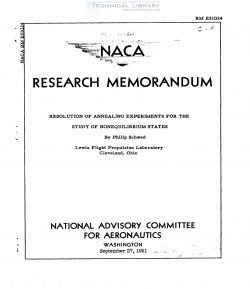naca-rm-e51g24
- Version
- 43 Downloads
- 669.49 KB File Size
- 1 File Count
- May 25, 2017 Create Date
- May 25, 2017 Last Updated
National Advisory Committee for Aeronautics, Research Memorandum - Resolution of Annealing Experiments for the Study of Nonequilibrium States

Insight into the condition of a solid which is not in the equilib-
rium state may be Obtained by determining the manner in which the prop-
erties of the solid change as it is annealed. In general, annealing is
done either by subjecting the sample to a series of fixed temperatures
or by steadily raising the temperature. In either case the way in which
the property studied changes during annealing makes it possible to dis-
tinguish nonequilibrium.states of sufficiently different activation
energies. A resolving power is defined herein for each of these two
techniques. Equations are derived which can be used to evaluate the
merits of an annealing experiment on the basis of these definitions.
For annealing with a steadily rising temperature, the defined
resolving power is nearly independent of the rate of temperature rise.
The numerical results depend, of course, on the dhosen definitions; but,
because of the way they are related, they provide a valid basis for a
comparison of these two (standard) methods. The separation in activa-
tion energies required for resolution increases as the order of the
annealing process increases; it is somewhat greater for annealing with
steadily rising temperatures than for annealing at fixed temperatures.
In both cases, the necessary separation is found to be of the order of
10 percent of the smaller activation energy.
The problem of matter in nonequilibrium states is of great impor—
tance in the case of solids, inasmuch as most solids encountered in
practice are not in thermodynamic equilibrium. The departure from equi-
librium.manifests itself by the deviation of certain properties, such
as stored energy, electric resistance, and so forth, from.their equilib—
rium.values; these properties, which allow conclusions to be drawn con—
cerning the nonequilibrium states, are called index properties.
A better insight into the nature of these states is provided by the
technique of annealing. In an annealing experiment, the rate at which
the material goes from the nonequilibrium state to some state closer to
equilibrium under the influence of thermal agitation is determined by
measuring the rate of change of one or several index properties as a
function of time and temperature. If some of the atoms of the material
are initially in the equilibrium state and the rest are initially in
some single nonequilibrium state, the data obtained in such an experi-
ment may be interpreted in terms of the number of atoms in either state
and the energy barrier separating the two states. In the more usual
case, however, a whole set of nonequilibrium states is available to the
atoms of the solid, in which case the experiment does not give clear-
cut information if the barriers separating the various nonequilibrium
states from the equilibrium state are only slightly different in height.
Thus, there is a definite restriction on the extent to which different
states can be distinguished in such an experiment.
| File | Action |
|---|---|
| naca-rm-e51g24 Resolution of Annealing Experiments for the Study of Nonequilibrium States.pdf | Download |

Comment On This Post